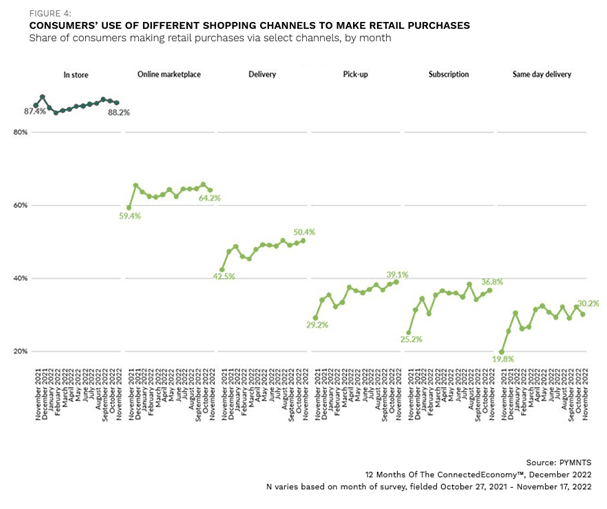
As overall retail sales slump, some sporting goods brands and merchants are demonstrating that health and wellness is anything but discretionary.
A seamless integration of online tools and technologies, when coupled with in-store sales savvy, is proving remarkably successful for sporting goods brands that strike the correct innovative balance. These cross-channel approaches to selling sporting goods and apparel leans into already established consumer behavior, as noted in the PYMNTS’ report, “12 Months of the ConnectedEconomy™.”

The data above indicates that consumers are shopping both online and in-store at relatively high rates, at 88% and 64% respectively. In order for brands and retailers to make the most of their potential consumer base, it thus seems clear that cross-channel strategies are essential. For the sporting goods and apparel space, some of these approaches have been more successful than others.
One merchant doing it “right” so far has been Dick’s Sporting Goods, as demonstrated by its 6.5% sales increase in the third quarter of 2022. Ed Stack, the company’s chief executive, directly attributes this growth to the retailer’s “best-in-class, omnichannel ecosystem.”
Dick’s digital shift was multilayered, yet each cross-channel offering was rolled out with remarkable speed. Starting last September, the retailer partnered with DoorDash, allowing its customers to opt for same-day delivery by ordering through the DoorDash platform. Weeks later, Dick’s announced a partnership with Peleton to launch 100 branded store-in-stores with the connected exercise company.
Dick’s growth has since continued to climb, with Q4 2022 same-store sales rising by 5.3%, exceeding analyst predictions. Led by purchases across footwear, athletic apparel and team sports products, Dick’s wrapped up the quarter with a record $3.6 billion in sales.
Nike is another household name who has found success with a hybrid approach that includes a direct-to-consumer (D2C) sales strategy. After the company’s stock dropped by half over 2021 and 2022, drastic changes were necessary if the 50-year-old brand had any chance of survival.
Focusing on its D2C and marketplace rollouts, Nike continued to push its plans for digital innovation, distribution changes and new retail concepts. However, rewards for these efforts were realized by last December, when Nike’s digital business grew 34% over the second quarter of 2022.
The company attributed this growth to “investing in markdowns” and using these promotions to attract new members and drive sales, along with its other D2C strategies. As with Dick’s Sporting Goods, success continued for Nike in the following quarter, as the company reported its Q3 revenue to be $12.4 billion, representing a 14% increase from the previous year and above projections. Notably, Nike’s brand digital sales rose 20% year-over-year.
Some retailers, such as Foot Locker, seem to have found more tempered but steady success with their cross-channel sales efforts. Catering to customers seeking a fun shopping experience drove the company’s sneaker sales, leading to better-than-expected results in Q3 2022. Total sales were up 3.3% year-over-year in constant currency terms, and comparable-store sales were up 0.8% during the same time period. While this growth was not nearly as dramatic as Dick’s or Nike, this growth came during a time when retail sales overall have declined, meaning 0.8% represents significant overperformance.
The company has also explored the D2C space, partnering last August with Fanatics. In the deal, Foot Locker is responsible for the front-end activities and Fanatics will fulfill those orders across an assortment of licensed merchandise across sports leagues such as MLB and the NFL.
The growth of these three brands demonstrate that applying the right strategies in the right markets at the right time may be able to turn even the most endangered companies around during difficult economic times.